Abstract
The stripmap mode is a basic and important mode for spaceborne synthetic aperture radars (SARs). Estimating the time-varying area observed by spaceborne SARs operating in stripmap mode is a practical but challenging field of research. In this article, we propose a novel method that parameterizes the time-varying area observed by the spaceborne SAR operating in the boresight stripmap mode into a fixed antenna attitude. Based on the principle of minimizing the dihedral angle between the plane containing the ideal estimated scatterers and the plane containing the actual parabolic antenna edge of a spaceborne SAR, an objective function is established for estimating the area observed by a spaceborne SAR operating in the boresight stripmap mode. Then, simulation experiments are designed to validate the feasibility and the robustness of the proposed method. The experimental simulation results show that the proposed method is feasible, and even under low signal-to-noise ratio (SNR) conditions of 10 dB, the proposed method still has good robustness.
1. Introduction
A spaceborne SAR is an important space payload equipped with microwave sensors for Earth observation and that has the advantages of wide observation coverage and the ability to operate under all-day and all-weather conditions. Therefore, it is widely used in strategic target surveillance, mapping, environmental monitoring, disaster monitoring, and resource explorations [1]. In order to meet the needs of different application scenarios, spaceborne SARs are usually configured in three basic operation modes: stripmap mode, scan mode, and spotlight mode [2]. Among them, the stripmap mode is the most fundamental and popular operation mode [1,2]. In this mode, the antenna of the spaceborne SAR points to a fixed direction with respect to the satellite body, the observation area illuminated by the antenna beam is a strip, and the images acquired by the spaceborne SAR are continuous, with the image resolution between the scan mode and the spotlight mode. Therefore, it is of great research significance to estimate the area observed by spaceborne SARs operating in stripmap mode, which is conducive to predicting the observation and detection intention and can provide prerequisite information for active defense and decision making.
As an important piece of space surveillance equipment, inverse synthetic aperture radars (ISARs) can obtain 2D and 3D images of space targets through ISAR imaging techniques. An ISAR can be used for the identification, classification, and attitude estimation of space targets [3]. Therefore, ISARs can be used to obtain image sequences of spaceborne SARs to estimate the area observed by spaceborne SARs operating in stripmap mode.
Since the area observed by the spaceborne SAR operating in stripmap mode is time-varying, in practice, it is difficult to establish a mathematical model to directly estimate it. Considering the characteristics of spaceborne SARs operating in stripmap mode, the time-varying observation area can be parameterized into the fixed attitude of the spaceborne SAR antenna. Therefore, the corresponding relation between the area observed by the spaceborne SAR operating in the stripmap mode and the fixed attitude of the spaceborne SAR’s antenna can be established. Then, by estimating the fixed attitude of the spaceborne SAR’s antenna, the area observed by the spaceborne SAR in the stripmap mode can be estimated.
Reviewing the relevant literature on the attitude estimation of space targets based on ISAR imaging technologies, the existing research methods can be generally sorted into the three following categories: (1) Three-dimensional structure reconstruction methods. A ground-based radar performs ISAR imaging for space targets from multiple perspectives; then, the relation between the observation geometry and the 3D structure of the space target is established, and the expression of the 3D structure of the space target is derived, thereby estimating the attitude of the space target. Drawing inspiration from the Structure From Motion (SFM) methods in the computer vision field [4,5], the radar observation matrix of space target scatterers can be decomposed using the Singular Value Decomposition (SVD) algorithm. Then, the structure matrix and measurement matrix are obtained to estimate the shape and position information of the space target in 3D space [6,7,8]. Interferometric Synthetic Aperture Radar (InSAR) imaging technology can be used to acquire instantaneous 3D point cloud models of space targets [9,10]. Subsequently, the space target’s attitude can be extracted by analyzing the 3D point cloud. However, the angular scattering phenomenon, which exists when scatterers on the space target are observed from multiple perspectives, affects the performance of the SVD algorithm. In addition, the phase ambiguity and interferometric baseline configuration issues are great challenges for interferometric ISAR imaging. The above problems cause the reconstructed 3D structure of the space target to be less stable, thereby affecting the accuracy of the space target attitude estimation. (2) Space target special structural feature extraction methods. In recent years, many scholars have proposed a large number of space target attitude estimation methods based on the special structural features of the space target body or components. The linear structural features of space target components are used in [11,12,13], the rectangular structure features of the space targets are used in [14,15], and the cuboid or cylindrical structural features of space targets are used in [16]. This type of algorithm utilizes the special structural feature constraints of the space targets to establish the estimation objective function, and achieves good estimation performance under the condition of a high signal-to-noise ratio (SNR). However, these algorithms usually require high-quality ISAR images when extracting special structural features; that is, the SNR must be high enough. In addition, the projection of linear structure and rectangular structure under certain observational perspectives may be a point and a line, which leads to failure in structural feature extraction and further affects the attitude estimation of space target. (3) Machine learning methods. With the development of artificial intelligence technology, some scholars have applied artificial intelligence algorithms to the attitude estimation of space targets and achieved some research results [17,18]. However, it is difficult to establish a perfect electromagnetic simulation model for non-cooperative space targets, so it is hard to obtain the massive set of training samples required by machine learning algorithms, which leads to difficulties in obtaining good estimation performance and limits the wide application of artificial intelligence technology in the field of space target attitude estimation.
There is almost no relevant research in the existing literature that directly estimates the time-varying area observed by spaceborne SARs operating in stripmap mode. In this article, we parameterize the time-varying area observed by a spaceborne SAR operating in stripmap mode into a fixed attitude of the spaceborne SAR’s antenna. Then, we construct an objective function by applying the principle of minimizing the dihedral angle between the plane containing the estimated scatterers of the parabolic antenna edge and the plane containing the actual parabolic antenna edge of the spaceborne SAR to estimate the fixed attitude of the spaceborne SAR’s antenna. Therefore, we can estimate the area observed by the spaceborne SAR in stripmap mode by estimating the fixed attitude of the spaceborne SAR antenna. The innovations of this article are as follows:
- (1)
- One-to-one correspondence is established between the time-varying area observed by the spaceborne SAR operating in boresight stripmap mode and the look angle of the spaceborne SAR’s antenna, which provides a new approach to estimating the time-varying area observed by spaceborne SARs operating in boresight stripmap mode.
- (2)
- According to the ISAR imaging model for spaceborne SAR, a concise expression of the ISAR projection matrix is obtained via matrix derivation.
- (3)
- The proposed algorithm has no special constraints on the antenna structure of the spaceborne SAR, and is only based on the coplanarity of the scatterers on the parabolic antenna edge or the panel antenna of the spaceborne SAR. In addition, an objective function to estimate the look angle of the spaceborne SAR operating in boresight stripmap mode is established, according to the principle of minimizing the dihedral angle between the plane containing the ideal estimated scatterers and the plane containing the actual parabolic antenna edge.
- (4)
- Based on the coplanarity of the scatterers on the parabolic antenna edge of a spaceborne SAR, it is easy to obtain an accurate normal vector of the antenna edge datum plane. In addition, using the dihedral angle to construct the objective function, the characteristic is obvious, the performance is stable, and the algorithm has good robustness.
The rest of this article is organized as follows. In Section 2, the characteristics of the spaceborne SAR operating in stripmap mode are analyzed, the model of the area observed by the spaceborne SAR operating in boresight stripmap mode is established, and the time-varying observation area is parameterized into a fixed look angle of the spaceborne SAR’s antenna. In Section 3, an ISAR imaging model for spaceborne SAR is established and an objective function to estimate the look angle of the spaceborne SAR operating in boresight stripmap mode is constructed. In Section 4, simulation experiments are designed to validate the feasibility and robustness of the proposed algorithm. In Section 5, some conclusions are drawn.
2. Geometry of Stripmap SAR Observation
In this section, the characteristics of the spaceborne SAR operating in stripmap mode are introduced, and the observation area is modeled.
2.1. Characteristics of Stripmap SAR
The most conventional imaging geometry of a spaceborne SAR operating in stripmap mode is referred to as boresight, with the antenna beam point being perpendicular to the flight path [2], as shown in Figure 1. The antenna beam illuminates the Earth with a fixed look angle and remains unchanged relative to the satellite body. In addition, a spaceborne SAR is usually equipped with an electrically scanned or mechanically scanned antenna. When the electrically scanned antenna beam is squinted, it causes beam broadening, grating lobe effects, and quantization effects, which lead to a decrease in imaging performance. The mechanically scanned antenna beam points in the same direction as the normal direction of the antenna, which avoids the beam broadening effect and the grating effect [19]. In addition, most SAR processing algorithms set the ground target at the zero Doppler time; that is, the antenna direction is perpendicular to the satellite flight path [20]. Therefore, in this article, a spaceborne SAR operating in stripmap mode is modeled for observing the Earth in boresight geometry; i.e., the antenna beam point is located within the zero Doppler plane, as shown in Figure 1.
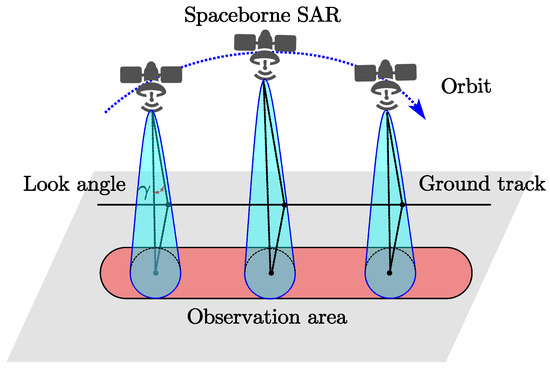
Figure 1.
Boresight imaging geometry of spaceborne SAR operating in stripmap mode.
2.2. Model of the Stripmap SAR Observation Area
As shown in Figure 2, the spaceborne SAR observes the Earth with a look angle of . is the intersection point of the normal line between the antenna and the ground, and are the intersection points of the beam edge and the ground in the zero Doppler plane, is the real-time position of the spaceborne SAR, is the sub-satellite point, and is the center of Earth. is drawn through and the vertical foot is . r and d are the radius of the spherical circle with as the center and passing through and the distance from to the sphere’s center, respectively. h is the orbital height and is the central angle . Therefore, r and d are expressed as
and
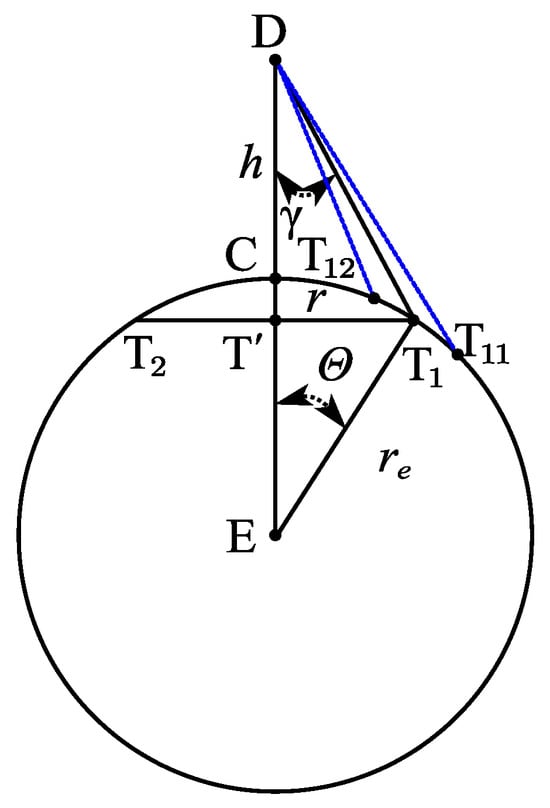
Figure 2.
Observation geometry of spaceborne SAR operating in stripmap mode.
As shown in Figure 3, is the real-time position of the spaceborne SAR and is the ascending node. is drawn perpendicular to the equatorial plane through and the vertical foot is . is drawn through and the vertical foot is . is the orbital inclination angle, which is denoted as i. , , and are defined in Figure 2. Therefore, and are the positions observed by the spaceborne SAR operating in boresight stripmap mode with the look angle .
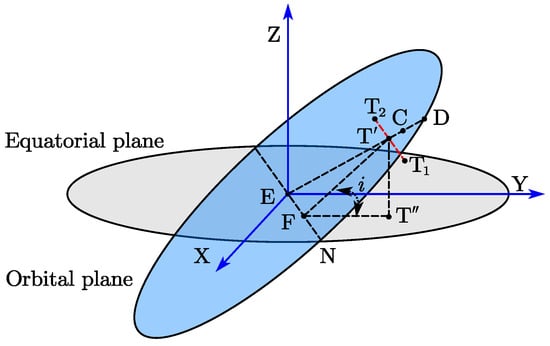
Figure 3.
Observation area of spaceborne SAR operating in stripmap mode.
Assume that the spaceborne SAR moves around the Earth from west to east. For convenience, the geodetic coordinates of sub-satellite point C, that is, the longitude and latitude, are denoted as . The geodetic coordinates of the area observed by the spaceborne SAR operating in stripmap mode are denoted as . Since , the angles of and with respect to the positive Z-axis direction are i and , respectively. Therefore, the following equation is obtained and expressed as
Since the research scenario is located in the northern hemisphere, the latitude range of the observation area is . Therefore, the following equation is obtained and expressed as
Because of , the following equation is obtained and expressed as
For convenience, when the spaceborne SAR observes the left area of the flight path, that is, the high latitude area, the geodetic coordinates of the observation area are denoted as , and when the spaceborne SAR observes the right area of the flight path, that is, the low latitude area, the geodetic coordinates of the observation area are denoted as . In addition, the relative longitude from the sub-satellite point to the ascending node is denoted as .
Substituting (3) and (4) into (5), when the spaceborne SAR observes the left area of the flight path, the geodetic coordinates of the observation area are expressed as
where , and means that is taken when , and is taken when .
When the spaceborne SAR observes the right area of the flight path, the geodetic coordinates of the observation area are expressed as
where , and “±” means that “+” is taken when , and “−” is taken when .
Equations (6) and (7) are functions of the look angle of the antenna. A one-to-one correspondence is established between the time-varying area observed by the spaceborne SAR operating in the boresight stripmap mode and the look angle of the antenna. Therefore, the area observed by the spaceborne SAR operating in stripmap mode can be estimated by estimating the look angle of the antenna.
3. ISAR Imaging and Method for Estimating the Stripmap SAR Observation Area
In this section, first, the coordinate systems to describe the ISAR imaging model are defined; then the ISAR imaging principles are derived and the ISAR imaging model for spaceborne SAR is established. Finally, an objective function is constructed to estimate the look angle of the spaceborne SAR antenna.
3.1. Coordinate Systems
In order to describe the model of the ground-based radar observing the spaceborne SAR and the attitude of the space target, at least two reference coordinate systems must be defined: the target body coordinate system and the spatial reference coordinate system [21]. In practice, some auxiliary coordinate systems are needed. In addition to the world geodetic system (WGS), satellite body coordinates (SB), station coordinates (ENU), Earth-centered, Earth-fixed coordinates (ECEF), and Earth-centered inertial coordinates (ECI) [22], the other three coordinate systems are defined as follows:
- (1)
- Component body coordinates (CB): . The component coordinate system and the satellite component are fixedly connected. When the satellite component is not moving, the component body coordinates and the satellite body coordinates coincide with each other. When the spaceborne SAR operating in boresight stripmap mode observes the Earth, it is rotated around the Y-axis to obtain the satellite body coordinates. This coordinate system is used to describe the satellite component attitude relative to the satellite body.
- (2)
- ISAR imaging coordinates system (IMG): . The origin O is the centroid of the space target, the positive X-axis is the same as the radar line-of-sight, the positive Z-axis is the same as the direction of the effective rotation vector of the space target, and the Y-axis and the X- and Z-axes form a right-handed Cartesian coordinate system. This coordinate system is used to describe the variations in the scatterers on the space target relative to the ISAR imaging plane.
- (3)
- Geocentric orbit reference coordinates (REF): . The origin E is the geocenter, the positive X-axis is the direction from the geocenter to the space target centroid at the zenith when the ground-based radar observes the space target, the Y-axis is in the orbital plane and perpendicular to the X-axis along the direction of tangential velocity, and the Z-axis, X-axis, and Y-axis form a Cartesian right-handed coordinate system. This coordinate system is used to describe the space target position.
3.2. ISAR Imaging Principle and Model
3.2.1. ISAR Imaging Principle
The 2D ISAR image of the space target in range and Doppler dimension is essentially the projection of the 3D scatterers of the space target on the ISAR imaging plane [23]. As shown in Figure 4, is the radar line-of-sight, is the angle between the space target rotation vector and the radar line-of-sight direction, and is the position vector of the scatterer P on the space target relative to the rotation center.
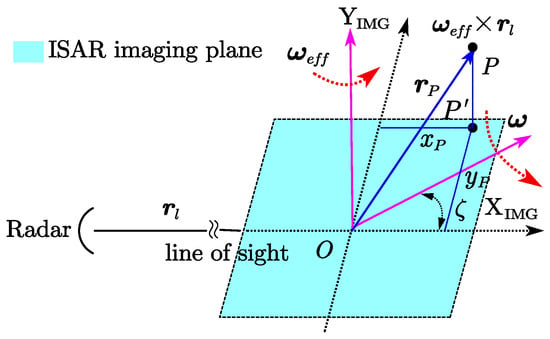
Figure 4.
Illustration of the ISAR imaging projection principle.
The range value of scatterer P in the ISAR image is expressed as
where .
The Doppler frequency shift caused by the rotation of the scatterer P is
where is the effective rotation vector of the space target.
The tangential velocity corresponding to the effective rotation vector is
From (9) and (10), the projection of the scatterer P in the direction of , that is, the Doppler value of the ISAR image, is
After cross-range scaling, the Doppler value of scatterer P in the ISAR image is
where .
3.2.2. ISAR Imaging Model for Spaceborne SAR
In this section, based on the defined coordinate systems and the principle of ISAR imaging, and under the assumption of the two-body orbit model, the ISAR imaging model for spaceborne SAR is established to derive the instantaneous ISAR imaging plane and the ISAR imaging projection matrix.
For convenience, we made a convention for the positive rotation direction. When rotating around a certain coordinate axis according to the right-hand rule, that is, with counterclockwise rotation, it is noted as the positive direction; otherwise, it is the negative direction. The coordinate transfer matrix is denoted as , where is the coordinate axis and is the rotation angle. The transfer matrix expressions are consistent with [22].
As shown in Figure 5, is the location of the radar station with geodetic coordinates ; is the real-time position of the spaceborne SAR; is the zenith when the ground-based radar is observing the spaceborne SAR; is the perigee; is the Greenwich hour angle; is the right ascension of the ascending node; is the argument of the perigee; is the true anomaly at zero time, that is, the time when the ground-based radar observes the spaceborne SAR passing the zenith; is true anomaly at time t; and is the angular velocity of the spaceborne SAR.
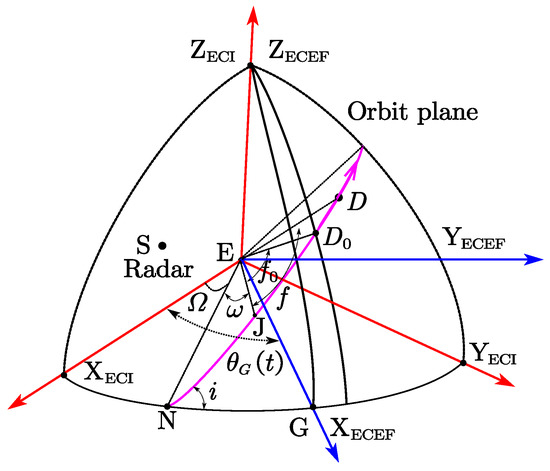
Figure 5.
Radar station and orbital elements of spaceborne SAR.
For convenience, assume that Earth is simplified as a standard sphere. Therefore, the coordinates of the radar station in the Earth-centered, Earth-fixed coordinates are expressed as
The transformation matrix from to is expressed as
The transformation matrix from to is expressed as
The transformation matrix and shift vector from to are expressed as
and
where , a is semi-major axis, and e is the eccentricity. Since a spaceborne SAR is generally a low-Earth satellite with a nearly circular orbit, is approximately equal to a.
In (10), the tangential velocity of radar line-of-sight vector is expressed as
In (13), (19), and (20), the real-time 2D ISAR imaging projection matrix is expressed as
where and . Therefore, the location of the radar station and the orbital elements of the spaceborne SAR determine the 2D ISAR imaging plane, which describes the projection from the satellite body coordinate system to the ISAR imaging coordinate system.
3.3. Method for Estimating the Stripmap SAR Observation Area
A spaceborne SAR is generally configured with a parabolic antenna or a panel phased array antenna, both of which have very distinctive edges. Cross-polarization ISAR images are very sensitive to the edges and corners of the target [24,25]. Therefore, based on the above characteristics, the scatterers on the space target components with edge features are easy to associate and extract from the ISAR image sequence. Without a loss of generality, in this article, a spaceborne SAR with a parabolic antenna is used as a typical research object, and its 3D model is shown in Figure 6. In addition, it is assumed that the main body of the spaceborne SAR is three-axis-stabilized and Earth-oriented, which is a relatively common satellite attitude control method [26,27].
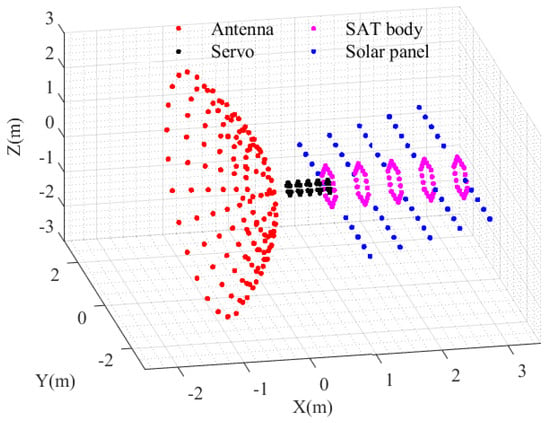
Figure 6.
Three-dimensional model of the spaceborne SAR.
As shown in Figure 7, for a spaceborne SAR operating in boresight stripmap mode, the component coordinate system is rotated around the Y-axis by a Euler angle to obtain the satellite body coordinate system. When the spaceborne SAR observes the left and right sides of the flight path, the corresponding Euler rotation angles are
and
where is the look angle of the antenna when the spaceborne SAR operating in boresight stripmap mode observes the Earth.
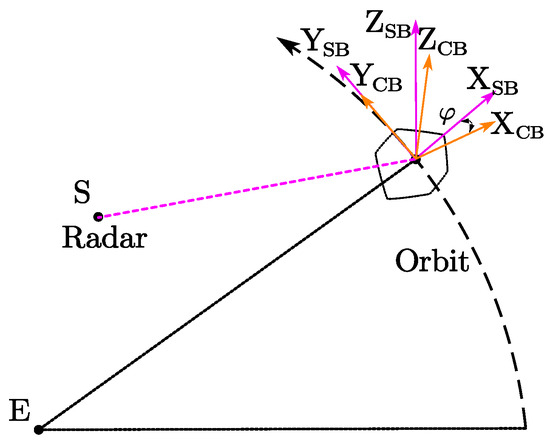
Figure 7.
Component coordinate system and satellite body coordinate system.
For any scatterer on the edge of the spaceborne SAR antenna, its position vector in the component body coordinate system is denoted as . In (21), (22), and (23), the range and Doppler in the SAR image at time t are expressed as
For convenience, the range and Doppler values of the ISAR image of the scatterer at time are denoted as and , respectively, and the projection vector in the range and Doppler dimension are denoted as and , respectively.
Therefore, the observation equation system constructed by the range and Doppler values of the ISAR image sequence of the scatterer at time is expressed as
where , and .
When the number of ISAR imaging moments , (25) is an overdetermined equation system, and its least square solution is expressed as
Assume that the range and Doppler values of n scatterers on the parabolic antenna edge at m moments are extracted from the ISAR image sequence. Therefore, the position vectors of these n scatterers in the component body coordinate system can be obtained from (25), which are expressed as
For a spaceborne SAR with a parabolic antenna, the scatterers on the parabolic antenna edge are all located in the same plane. The unit normal vector of this plane in the component body coordinate system is expressed as
For convenience, the number of combinations of M elements selected from N elements is denoted as . A plane can be constructed using any three scatterers, , , and , on the parabolic antenna edge in (25), and the corresponding normal vector is expressed as
Therefore, by selecting any three scatterers from the n scatterers on the parabolic antenna edge solved in (27), a total of planes can be constructed, and the corresponding normal vectors, as in (29), can be obtained, which are denoted as , where .
In (28) and (29), the mean value of the dihedral angles between the planes constructed by the n scatterers on the parabolic antenna edge in (27) and the plane containing the actual parabolic antenna edge of the spaceborne SAR is expressed as
Equation (30) is a function of the look angle when the spaceborne SAR operating in boresight stripmap mode observes the Earth. When the estimated area observed by the spaceborne SAR is operating in boresight stripmap mode, that is, the estimated look angle is ideal, (30) is approximately zero or the global minimum.
Equation (30) is a highly nonlinear function of the look angle . Based on (30), algorithms such as pattern search algorithms, swarm optimization algorithms, and linear search algorithms can be used to estimate the area observed by the spaceborne SAR operating in boresight stripmap mode.
Since the area observed by the spaceborne SAR operating in boresight stripmap mode is parameterized into a look angle of the antenna, the linear search algorithm can meet the requirements of parameter estimation. The flow of the proposed method is as follows: (1) Set the range of the look angle, generally 15° to 55° [28], and set the search step length to obtain the search set. (2) For each element in the search set, according to (26) and (27), the estimated coordinates in the component body coordinate system of the scatterers on the parabolic antenna edge are obtained. (3) For each element in the search set, from (30), the mean value of dihedral angles between the plane constructed by estimated scatterers and the plane containing actual parabolic antenna edge of the spaceborne SAR is obtained. (4) The look angle in the search set corresponding to the minimum dihedral angle is the estimated look angle.
4. Simulation Experiments
In this section, the method of generating experimental data is given. Then, methodologies for the feasibility verification experiment and robustness validation experiment are designed.
4.1. Experimental Data Generation
Due to the confidentiality of the measured data, simulation data were used to verify and analyze the proposed method. Therefore, first, the parameters for ISAR imaging the spaceborne SAR were set. The orbital elements of spaceborne SAR are shown in Table 1. The ground-based radar parameters were consistent with the Tracking and Imaging Radar (TIRA) space observation radar [28], and the detailed parameters are shown in Table 2. The 3D model of the spaceborne SAR is shown in Figure 6. The diameter of the parabolic antenna was 6 m and the focal ratio was 0.4. The radar station location parameters are shown in Table 3.

Table 1.
Orbital parameters of the spaceborne SAR.

Table 2.
Ground-based radar parameters.

Table 3.
Radar station location.
Since the spaceborne SAR is a low-Earth satellite, its movement adopts a two-body orbit model. Considering the commonly used satellite attitude control methods, it is assumed that the main body of the spaceborne SAR is three-axis-stabilized and Earth-oriented. In addition, since the satellite’s attitude control system has high precision [29,30], the impact of the orbit attitude on the estimation accuracy of the proposed method can be ignored in this article. According to the satellite visibility method, within 24 h from the spaceborne SAR orbit epoch time, the ground-based radar observes a total of five visible arcs of the spaceborne SAR. The main information of the visible arcs is shown in Table 4. Without a loss of generality, the visible arc, Arc-1, with a low elevation angle, and the visible arc, Arc-3, with a high elevation angle, are selected as typical research representatives in this experiment; they are denoted as LowEleArc and HighEleArc, respectively.

Table 4.
Visible arc information of ground-based radar observing spaceborne SAR.
According to the ISAR imaging projection principle and the ISAR imaging model for spaceborne SAR, the 2D ISAR image sequence of the ISAR imaging the spaceborne SAR within the LowEleArc and HighEleArc can be generated as experimental observation data. As shown in Figure 8, the range and Doppler values of the scatterers on the parabolic antenna edge can be extracted from the ISAR image sequence to estimate the area observed by the spaceborne SAR operating in boresight stripmap mode.
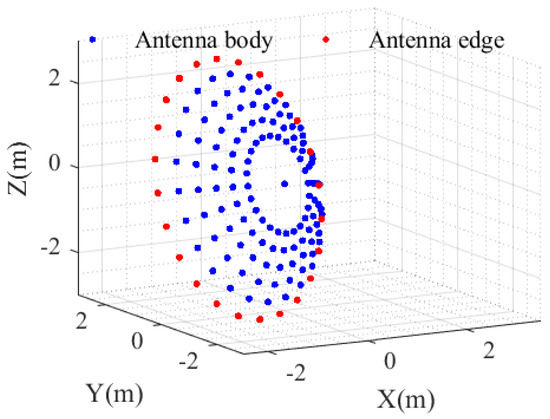
Figure 8.
Three-dimensional model of the spaceborne SAR parabolic antenna.
4.2. Feasibility Verification Experimental Methodology
In order to validate the feasibility of the proposed method and evaluate the impact of the quantification error of the search scope on the estimation accuracy, the range and Doppler values of the scatterers on the parabolic antenna edge extracted from the ISAR image sequence are error-free in the feasibility verification experiment.
The flowchart of the feasibility verification experiment is shown in Figure 9. Step 1: Set the ISAR imaging parameters. Set the search scope of the look angle to 15–55. Set the actual look angle of the spaceborne SAR antenna to 35. Step 2: Obtain all the visible arcs when the ground-based radar observes spaceborne SAR, within 24 h from the spaceborne SAR orbit epoch time, and select the LowEleArc and HighEleArc as experimental arcs. Step 3: According to the sliding window shown in Figure 10, obtain an experimental arc segment. Step 4: Generate the ISAR image of spaceborne SAR during the experimental arc segment. Step 5: Extract the range and Doppler values of the scatterers on the parabolic antenna edge. Step 6: Obtain the position vectors of scatterers on the parabolic antenna edge using (27). Step 7: Randomly generate the search step between 0.02 and 0.029 and quantify the search scope according to the search step length to obtain a search set. Step 8: Calculate the values of the objective function (30) in the search set. Step 9: Find the minimum value of the the objective function (30) to obtain the estimated look angle. Step 10: If the sliding window process has not ended, go to Step 3; otherwise, the experiment ends and all the estimated look angles are obtained.
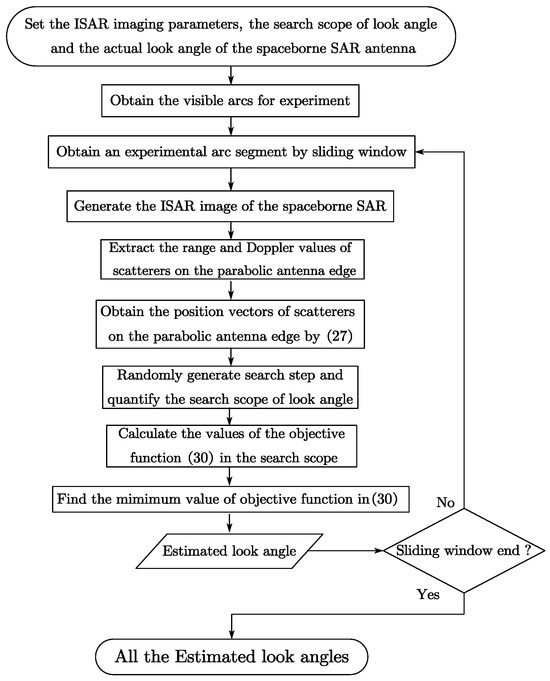
Figure 9.
Flowchart of the feasibility verification experiment.
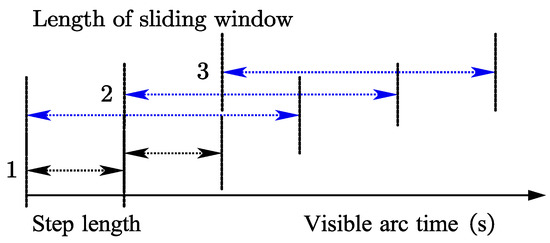
Figure 10.
Illustration of the sliding window within the visible arc.
4.3. Robustness Validation Experimental Methodology
In order to evaluate the robustness of the method proposed, arc segments in LowEleArc and HighEleArc, shown in Figure 11, were selected as experimental objects. Gaussian noise conditions of 10 dB, 15 dB, and 20 dB were added to the ISAR image sequence, respectively, and under each noise condition, 100 Monte Carlo experiments were performed for each experimental arc segment to evaluate the robustness of the proposed method in the robustness validation experiment.
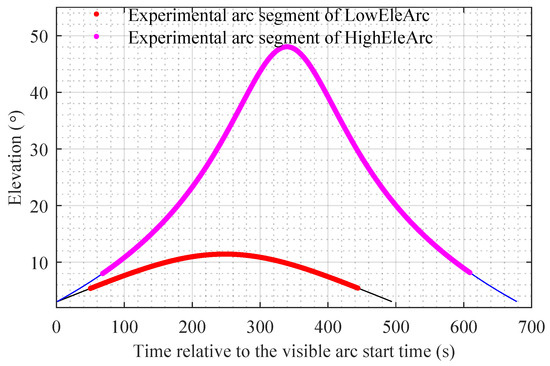
Figure 11.
Arc segments used for Monte Carlo experiments in the low and high elevation arcs. LowEleArc: low elevation arc. HighEleArc: High elevation arc.
The flowchart of the robustness validation experiment is shown in Figure 12. Step 1: Set the ISAR imaging parameters. Set the search scope of the look angle to 15–55. Set the search step length to 0.026. Set the random noise conditions to 10 dB, 15 dB, and 20 dB. Set the number of Monte Carlo experiments to 100. Set the actual look angle of the spaceborne SAR antenna to 35. Step 2: Obtain all the visible arcs when the ground-based radar observes spaceborne SAR, within 24 h from the spaceborne SAR orbit epoch time, and select the LowEleArc and HighEleArc as experimental arcs. Step 3: According to the sliding window shown in Figure 11, obtain two experimental arc segments. Step 4: Obtain the random noise parameters. Step 5: Generate the ISAR image of spaceborne SAR during the experimental arc segment. Step 6: Extract the range and Doppler values of the scatterers on the parabolic antenna edge. Step 7: Obtain the position vectors of scatterers on the parabolic antenna edge using (27). Step 8: Quantify the search scope according to the search step length to obtain a search set. Step 9: Calculate the values of the objective function (30) in the search set. Step 10: Find the minimum value of the the objective function (30) to obtain the estimated look angle. Step 11: If the Monte Carlo experiment has not ended, go to Step 5; otherwise, if the traversal of different noise conditions has not ended, go to Step 4; otherwise, the experiment ends and all the estimated look angles are obtained.
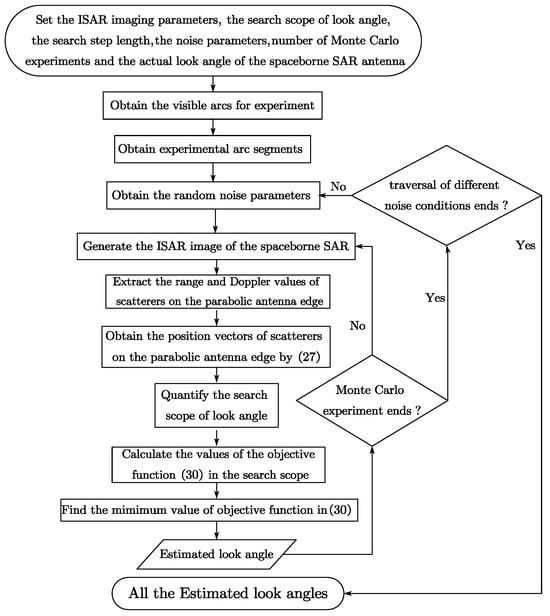
Figure 12.
Flowchart of the robustness validation experiment.
5. Experimental Results and Analysis
In this section, the results of the feasibility verification experiment are shown and analyzed. Then, the results of the robustness validation experiment are shown and analyzed.
5.1. Feasibility Results and Analysis of the Algorithm for Minimizing the Dihedral Angle between the Estimated Plane and Actual Plane
Figure 13 shows the geometrical relation between the plane containing the scatterers estimated using (27) on the parabolic antenna edge, under the condition of a non-ideal look angle, and the plane containing the actual parabolic antenna edge of spaceborne SAR. There is a very obvious dihedral angle between the two planes. Therefore, it is feasible to construct the objective function in (30). Although the spaceborne SAR model in this article is based on the assumption that the spaceborne SAR has a parabolic antenna, it is still applicable for electronically scanned phased array panel antennas because the proposed method is based on the coplanarity of the scatterers of the spaceborne SAR antenna, which is not limited to a paraboloidal shape or a rectangular shape.
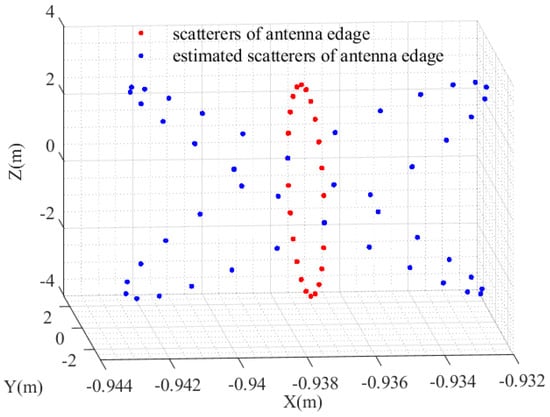
Figure 13.
The plane containing the scatterers of the parabolic antenna edge vs. the plane containing the estimated scatterers under the non-ideal look angle.
Figure 14 and Figure 15 show the estimation error distributions of the antenna look angle when the spaceborne SAR is operating in boresight stripmap mode using low-elevation arc segments and high-elevation arc segments. It is obvious that, for all the estimated arc segments, the estimation errors of the look angle are within the quantization unit of the search scope, and the proposed method has high accuracy and good performance. Therefore, the feasibility of the method proposed in this article is validated.

Figure 14.
Look angle estimation errors in the experimental arc segments of LowEleArc. LowEleArc: low elevation arc.
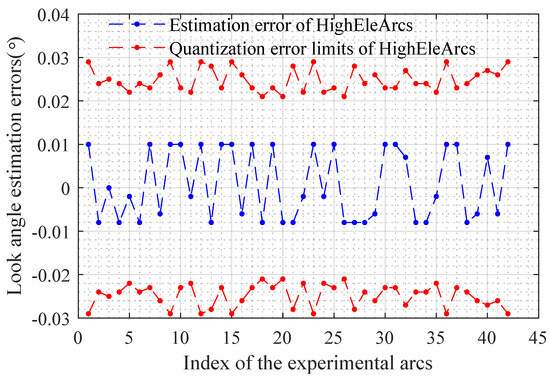
Figure 15.
Look angle estimation errors in the experimental arc segments of HighEleArc. HighEleArc: High elevation arc.
Although, in this experiment, based on the advantages of a spaceborne SAR operating in boresight stripmap mode and the common practice in the industry, the model is performed under the assumption that the spaceborne SAR operates in boresight stripmap mode, the method proposed in this article is still applicable for scenarios in which the spaceborne SAR operates in squinted mode. In the squinted case, it is only necessary to assume that the antenna component performs yaw and roll rotation relative to the satellite body, and then perform the two-dimensional search.
In addition, the proposed method has no constraints on whether the antenna component of the spaceborne SAR can move relative to the main body of the spaceborne SAR, because this article only uses the relative positional relation between the main body of the spaceborne SAR and the antenna component. Even if the antenna of the spaceborne SAR is fixed, it can still be assumed that the antenna of the spaceborne SAR reaches the actual attitude by rotating in the yaw and roll directions relative to the main body of the spaceborne SAR.
5.2. Robustness Results and Analysis of the Algorithm for Minimizing the Dihedral Angle between the Estimated Plane and Actual Plane
Figure 16 and Figure 17 show the estimation error distributions of 100 Monte Carlo experiments using the experimental arc segments of LowEleArc and HighEleArc to estimate the look angle of the antenna when the spaceborne SAR is operating in boresight stripmap mode, respectively. Whether the LowEleArc experimental arc segment or the HighEleArc experimental arc segment is used, the estimation accuracy of the look angle increases with the increase in the SNR. In addition, the estimation accuracy using the HighEleArc arc segment is higher than that using the LowEleArc arc segment. Table 5 shows the statistical eigenvalues of the estimation errors of the antenna look angle of the spaceborne SAR operating in boresight stripmap mode obtained after 100 Monte Carlo experiments using the LowEleArc and HighEleArc experimental arc segments. The experimental results show that the method proposed in this article has high accuracy, good estimation performance, and high confidence in the estimation results. Even under the low SNR condition of 10 dB, the mean value of the look angle estimation errors using the LowEleArc arc segment is 0.0156°, and the variance is 0.1487°; the mean value of the look angle estimation errors using the HighEleArc arc segment is 0.0031°, and the variance is 0.0337°. Therefore, the performance of the proposed method is still good.

Figure 16.
The look angle estimation errors with the LowEleArc segment under the Gaussian noise conditions of 10 dB, 15 dB, and 20 dB. LowEleArc: low elevation arc.
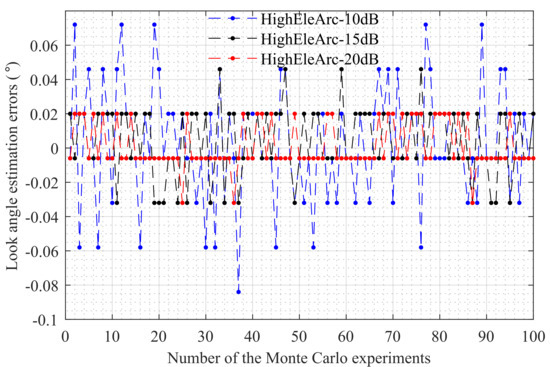
Figure 17.
The look angle estimation errors with the HighEleArc segment under the Gaussian noise conditions of 10 dB, 15 dB, and 20 dB. HighEleArc: High elevation arc.

Table 5.
Eigenvalue statistics for the look angle estimation in the low and high elevation arc segments.
Based on the above experimental results, the method proposed in this article has good robustness. Therefore, the robustness of the proposed method in this article is validated.
The proposed method has good robustness because the coplanarity of the scatterers on the antenna component of the spaceborne SAR is easily satisfied, and the normal vector of the selected antenna datum plane is easy to obtain and very accurate. In addition, the normal vector of the datum plane of the selected spaceborne SAR antenna is not necessarily along the positive direction of the X-axis, as chosen in this article. It can be selected as needed according to the definition of the satellite body coordinate system and the component body coordinate system.
6. Conclusions
In this article, we propose a novel method for estimating the area observed by spaceborne SARs operating in boresight stripmap mode. We establish the corresponding relation between the observation area and the fixed attitude of the spaceborne SAR antenna, and parameterize the time-varying area observed by the spaceborne SAR into a fixed look angle of the spaceborne SAR antenna. Based on the coplanarity of the scatterers on the parabolic antenna edge of the spaceborne SAR and the principle of minimizing the dihedral angle between the plane containing the ideal estimated scatterers and the plane containing the actual parabolic antenna edge of the spaceborne SAR, an objective function is established and a linear search algorithm is used to estimate the look angle of the spaceborne SAR antenna. Then, experiments are designed to validate the feasibility and robustness of the proposed method. Under the assumption of no errors in the range and Doppler values of the scatterers on the parabolic antenna edge extracted from the ISAR image sequence, the estimation errors of the proposed method are within the quantization unit of the search scope. Therefore, the feasibility of the proposed method is validated. Under the Gaussian noise conditions of 10 dB, 15 dB, and 20 dB in the ISAR image sequence, the estimation performance of the proposed method is greatly superior, and even under a low SNR condition of 10 dB, the performance of the proposed method is still good. Therefore, the robustness of the proposed method is validated in this article.
Author Contributions
Conceptualization, T.F., D.C., H.C., J.W. and B.L.; methodology, B.L.; software, B.L., H.L. and S.Z.; validation, B.L.; formal analysis, B.L.; investigation, B.L., H.L., L.Z. and S.Z.; writing—original draft, B.L.; writing—review and editing, T.F., D.C., H.C., J.W., H.L., S.Z. and L.Z. All authors have read and agreed to the published version of the manuscript.
Funding
This work was supported by the National Natural Science Foundation of China under Grant 62071041 and the National Natural Science Foundation of China under Grant 62201041.
Data Availability Statement
The data presented in this article are available upon request from the corresponding authors.
Acknowledgments
The authors are grateful to the anonymous reviewers for their careful review and constructive comments.
Conflicts of Interest
The authors declare no conflict of interest.
Abbreviations
The following abbreviations are used in this manuscript:
| SAR | Synthetic aperture radar |
| ISAR | Inverse synthetic aperture radar |
| TIRA | Tracking and imaging radar |
| SFM | Structure from motion |
| SVD | Singular value decomposition |
| InSAR | Interferometric synthetic aperture radar |
| SNR | Signal-to-noise ratio |
References
- Moreira, A.; Prats-Iraola, P.; Younis, M.; Krieger, G.; Hajnsek, I.; Papathanassiou, K.P. A tutorial on synthetic aperture radar. IEEE Geosci. Remote Sens. Mag. 2013, 1, 6–43. [Google Scholar] [CrossRef]
- Franceschetti, G.; Lanari, R. Synthetic Aperture Radar Processing; CRC Press: Boca Raton, FL, USA, 1999. [Google Scholar]
- Ozdemir, C. Inverse Synthetic Aperture Radar Imaging with MATLAB Algorithms; John Wiley & Sons: Hoboken, NJ, USA, 2021. [Google Scholar]
- Ma, Y.; Soatto, S.; Košecká, J.; Sastry, S. An Invitation to 3-d Vision: From Images to Geometric Models; Springer: Berlin/Heidelberg, Germany, 2004; Volume 26. [Google Scholar]
- Hartley, R.; Zisserman, A. Multiple View Geometry in Computer Vision; Cambridge University Press: Cambridge, UK, 2003. [Google Scholar]
- Liu, L.; Zhou, F.; Bai, X.R.; Tao, M.L.; Zhang, Z.J. Joint cross-range scaling and 3D geometry reconstruction of ISAR targets based on factorization method. IEEE Trans. Image Process. 2016, 25, 1740–1750. [Google Scholar] [CrossRef] [PubMed]
- Tomasi, C.; Kanade, T. Shape and motion from image streams: A factorization method. Proc. Natl. Acad. Sci. USA 1993, 90, 9795–9802. [Google Scholar] [CrossRef] [PubMed]
- Morita, T.; Kanade, T. A sequential factorization method for recovering shape and motion from image streams. IEEE Trans. Pattern Anal. Mach. Intell. 1997, 19, 858–867. [Google Scholar] [CrossRef]
- Rong, J.; Wang, Y.; Han, T. Interferometric ISAR imaging of maneuvering targets with arbitrary three-antenna configuration. IEEE Trans. Geosci. Remote Sens. 2019, 58, 1102–1119. [Google Scholar] [CrossRef]
- Zhao, L.; Gao, M.; Martorella, M.; Stagliano, D. Bistatic three-dimensional interferometric ISAR image reconstruction. IEEE Trans. Aerosp. Electron. Syst. 2015, 51, 951–961. [Google Scholar] [CrossRef]
- Zhou, Y.; Zhang, L.; Wang, H.; Qiao, Z.; Hu, M. Attitude estimation of space targets by extracting line features from ISAR image sequences. In Proceedings of the 2017 IEEE International Conference on Signal Processing, Communications and Computing (ICSPCC), Xiamen, China, 22–25 October 2017; pp. 1–4. [Google Scholar]
- Duan, J.; Xie, P.; Zhang, L.; Ma, Y. Space target dynamic identification by exploiting geometrical feature flow from ISAR image sequences. IEEE Sens. J. 2022, 22, 21877–21884. [Google Scholar] [CrossRef]
- Xie, P.; Zhang, L.; Du, C.; Wang, X.; Zhong, W. Space target attitude estimation from ISAR image sequences with key point extraction network. IEEE Signal Process. Lett. 2021, 28, 1041–1045. [Google Scholar] [CrossRef]
- Zhou, Y.; Zhang, L.; Cao, Y.; Wu, Z. Attitude estimation and geometry reconstruction of satellite targets based on ISAR image sequence interpretation. IEEE Trans. Aerosp. Electron. Syst. 2018, 55, 1698–1711. [Google Scholar] [CrossRef]
- Wang, J.; Li, Y.; Song, M.; Xing, M. Joint estimation of absolute attitude and size for satellite targets based on multi-feature fusion of single ISAR image. IEEE Trans. Geosci. Remote Sens. 2022, 60, 1–20. [Google Scholar] [CrossRef]
- Wang, J.; Du, L.; Li, Y.; Lyu, G.; Chen, B. Attitude and size estimation of satellite targets based on ISAR image interpretation. IEEE Trans. Geosci. Remote Sens. 2021, 60, 1–15. [Google Scholar] [CrossRef]
- Afshar, R.; Lu, S. Classification and recognition of space debris and its pose estimation based on deep learning of CNNs. In Proceedings of the HCI International 2020-Posters: 22nd International Conference, HCII 2020, Copenhagen, Denmark, 19–24 July 2020; Proceedings, Part I 22. Springer: Berlin/Heidelberg, Germany, 2020; pp. 605–613. [Google Scholar]
- Arakawa, R.; Matsushita, Y.; Hanada, T.; Yoshimura, Y.; Nagasaki, S. Attitude estimation of space objects using imaging observations and deep learning. In Proceedings of the Advanced Maui Optical and Space Surveillance Technologies Conference, Maui, HI, USA, 17–20 September 2019; p. 21. [Google Scholar]
- Bovik, A.C. Handbook of Image and Video Processing; Academic Press: Cambridge, MA, USA, 2010. [Google Scholar]
- Cumming, I.; Wong, F. Digital Processing of Synthetic Aperture Radar Data: Algorithms and Implementation; Artech House: Norwood, MA, USA, 2005. [Google Scholar]
- Markley, F.; Crassidis, J. Fundamentals of Spacecraft Attitude Determination and Control; Springer: New York, NY, USA, 2014. [Google Scholar]
- Vallado, D.A. Fundamentals of Astrodynamics and Applications; Springer Science & Business Media: Berlin/Heidelberg, Germany, 2001; Volume 12. [Google Scholar]
- Li, G.; Liu, Y.; Wu, L.; Xu, S.; Chen, Z. Three-dimensional reconstruction using ISAR sequences. In Proceedings of the MIPPR 2013: Pattern Recognition and Computer Vision, Wuhan, China, 26–27 October 2013; Volume 8919, pp. 43–49. [Google Scholar]
- Wang, F.; Eibert, T.F.; Jin, Y.Q. Simulation of ISAR imaging for a space target and reconstruction under sparse sampling via compressed sensing. IEEE Trans. Geosci. Remote Sens. 2015, 53, 3432–3441. [Google Scholar] [CrossRef]
- Zhang, Y.; Yang, X.; Jiang, X.R.; Yang, Q.; Deng, B.; Wang, H.Q. Attitude direction estimation of space target parabolic antenna loads using sequential terahertz ISAR images. J. Infrared Millim. Waves 2021, 40, 497–507. [Google Scholar]
- Wertz, J.R. Spacecraft Attitude Determination and Control; Springer Science & Business Media: Berlin/Heidelberg, Germany, 2012; Volume 73. [Google Scholar]
- Shaviv, G.; Shachar, M. TechSAT-1–an earth-pointing, three-axis stabilized microsatellite. Space Technol. 1995, 4, 245–256. [Google Scholar] [CrossRef]
- Sun, G.C.; Liu, Y.; Xiang, J.; Liu, W.; Xing, M.; Chen, J. Spaceborne synthetic aperture radar imaging algorithms: An overview. IEEE Geosci. Remote Sens. Mag. 2021, 10, 161–184. [Google Scholar] [CrossRef]
- Iwata, T.; Yoshizawa, T.; Hoshino, H.; Maeda, K. Precision attitude and orbit control system for the advanced land observing satellite. In Proceedings of the AIAA Guidance, Navigation, and Control Conference and Exhibit, Austin, TX, USA, 11–14 August 2003; p. 5783. [Google Scholar]
- Lee, S.; Park, S.Y.; Kim, J.; Ka, M.H.; Song, Y. Mission Design and Orbit-Attitude Control Algorithms Development of Multistatic SAR Satellites for Very-High-Resolution Stripmap Imaging. Aerospace 2022, 10, 33. [Google Scholar] [CrossRef]
Disclaimer/Publisher’s Note: The statements, opinions and data contained in all publications are solely those of the individual author(s) and contributor(s) and not of MDPI and/or the editor(s). MDPI and/or the editor(s) disclaim responsibility for any injury to people or property resulting from any ideas, methods, instructions or products referred to in the content. |
© 2023 by the authors. Licensee MDPI, Basel, Switzerland. This article is an open access article distributed under the terms and conditions of the Creative Commons Attribution (CC BY) license (https://creativecommons.org/licenses/by/4.0/).